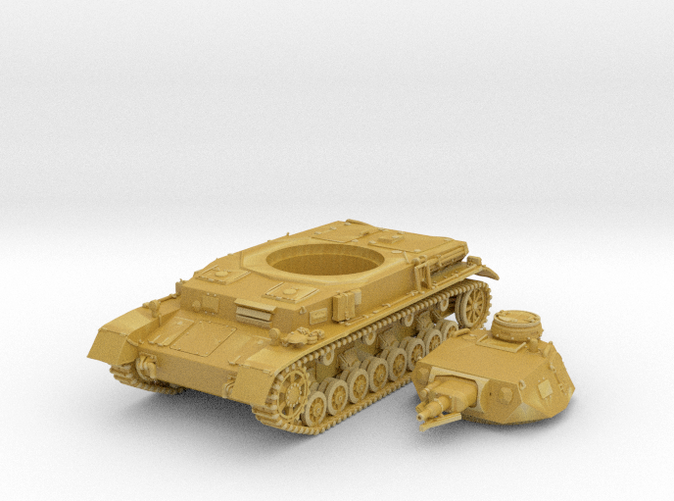1/160 Scale WW2 German Army Pz.Kpfw. IV Ausf. C Medium Tank.
Highly detailed tank with accurate Track detail and moveable Turret.
Contains:- 1x Pz.Kpfw. IV Ausf. C Medium Tank
Pz.Kpfw. IV Ausf. C Medium Tank
The
Panzerkampfwagen IV (
PzKpfw IV), commonly known as the
Panzer IV, was a
German medium tank developed in the late 1930s and used extensively during the
Second World War. Its ordnance inventory designation was
Sd.Kfz. 161.
The Panzer IV was the most widely manufactured
German tank of the Second World War, with some 8,500 built. The Panzer IV was used as the base for many other fighting vehicles, including the
Sturmgeschütz IV assault gun,
Jagdpanzer IV tank destroyer, the
Wirbelwind self-propelled anti-aircraft gun, and the
Brummbär self-propelled gun.
The Panzer IV saw service in all combat theaters involving Germany and was the only German tank to remain in continuous production throughout the war. Upgrades and design modifications, intended to counter new threats, extended its service life. Generally, these involved increasing the Panzer IV's
armor protection or upgrading its weapons, although during the last months of the war, with Germany's pressing need for rapid replacement of losses, design changes also included simplifications to speed up the manufacturing process.
The Panzer IV was partially succeeded by the
Panther medium tank, which was introduced to counter the Soviet
T-34, although the Panzer IV continued as a significant component of German armoured formations to the end of the war. The Panzer IV was the most widely exported tank in German service, with around 300 sold to Finland, Romania, Spain and Bulgaria. After the war, Syria procured Panzer IVs from France and Czechoslovakia, which saw combat in the 1967
Six-Day War. 8,553 Panzer IVs of all versions were built during World War II, with only the
StuG III assault-gun/tank destroyer's 10,086 vehicle production run exceeding the Panzer IV's total among Axis armored forces.
After manufacturing 35 tanks of the A version, in 1937 production moved to the Ausf. B. Improvements included the replacement of the original engine with the more powerful 300 PS (220.65 kW) Maybach HL 120TR, and the transmission with the new SSG 75 transmission, with six forward gears and one reverse gear. Despite a weight increase to 16 t (18 short tons), this improved the tank's speed to 42 kilometres per hour (26.10 mph). The
glacis plate was augmented to a maximum thickness of 30 millimetres (1.18 in), while a new driver's visor was installed on the straightened hull front plate, and the hull-mounted machine gun was replaced by a covered pistol port and visor flap. The superstructure width and ammunition stowage were reduced to save weight. A new commander's cupola was introduced which was adopted from the Panzer III Ausf. C. A
Nebelkerzenabwurfvorrichtung (smoke grenade discharger rack) was mounted on the rear of the hull starting in July 1938 and was back fitted to earlier Ausf. A and Ausf. B chassis starting in August 1938. Forty-two Panzer IV Ausf. Bs were manufactured before the introduction of the Ausf. C in 1938. This saw the turret armor increased to 30 mm (1.18 in), which brought the tank's weight to 18.14 t (20.00 short tons). After assembling 40 Ausf. Cs, starting with chassis number 80341, the engine was replaced with the improved HL 120TRM. The last of the 140 Ausf. Cs was produced in August 1939
Some part cleanup will be necessary. The 3D printing process uses a waxy substance to support certain part features during the printing process. Although the parts are cleaned by Shapeways, some waxy residue may remain. It can be safely removed with water and a mild aqueous detergent like "Simple Green" using an old, soft toothbrush, Q-tips or pipe cleaners. Customers report that "Bestine" and "Goo Gone" also work well.During the printing process, liquid resin is cured by ultraviolet light. Microscopic bits of resin may remain uncured.
Let your parts sit in direct sunlight for a few hours to fully cure the resin.
Water-based acrylic paints meant for plastics is strongly recommended. Other paints, especially enamels, may not cure on Frosted Detail 3D-printed plastics.
Use dedicated model sprue cutters to remove parts to minimise the risk of damage to parts.
Please take a look at my other items.
Painting tips and preparation
